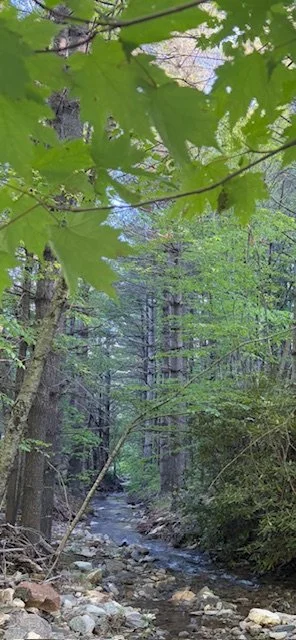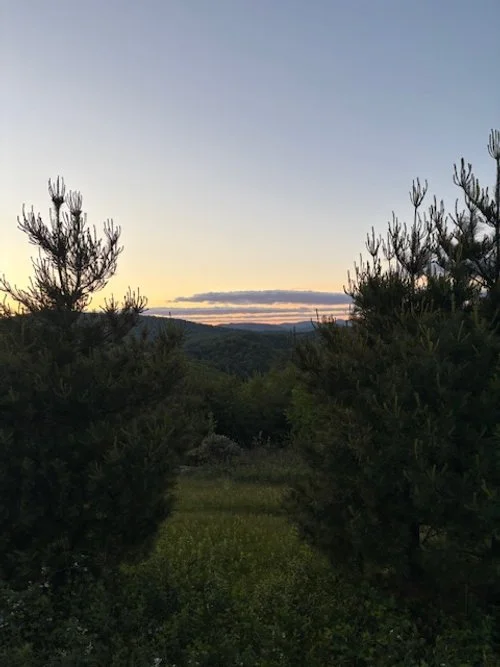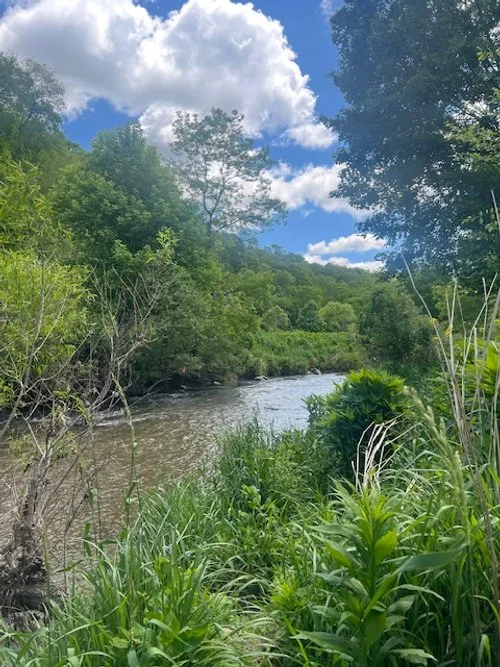Forest Bathing: What the Latest Science Reveals
Shinrin Yoku: What the Latest Science Reveals About Its Magic
By Mark Bucha, ANFT Certified Forest Therapy Guide
The Forest Is Calling—and Science Is Finally Listening
A few weeks ago, during a guided forest therapy walk near Columbus Ohio, a woman sat beneath a maple tree, eyes closed, palms open on her knees. After a long pause, she whispered, “I feel like the forest just held me.” I smiled—because I knew exactly what she meant.
As a forest therapy guide, I’ve seen dozens of people experience that same shift: from overwhelmed and over-connected to grounded and present. And now, more than ever, science is catching up with what we’ve intuitively known for centuries—spending time immersed in nature heals us. Profoundly.
So, let’s explore together what Shinrin Yoku, or forest bathing, really is—and what the latest research says about its magic.
What Is Shinrin Yoku, Really?
You’ve probably heard the term tossed around in wellness circles or on social media. But let’s clarify: Shinrin Yoku is a Japanese term that translates to “forest bathing.” It doesn’t involve swimming in a creek or breaking a sweat on a hiking trail. Instead, it means mindfully immersing yourself in the atmosphere of the forest, fully engaging your senses.
The practice began in Japan in the 1980s as a response to rising levels of burnout, anxiety, and illness among city dwellers. The Japanese government even backed it with public health campaigns and research initiatives. And the results were—and still are—stunning.
The Science Behind Why It Feels So Good
Let’s get into what happens when you walk through a forest slowly, attentively, and without distraction.
The Brain Loves Nature’s Simplicity
When you step into the forest, your brain shifts gears. Instead of being bombarded by urban stimuli—emails, traffic, background noise—it engages in what scientists call “soft fascination”. That’s the gentle, effortless attention you give to the sway of branches, the chirping of birds, or the pattern of leaves overhead (Kaplan, 1995).
This state helps restore our prefrontal cortex, the part of the brain responsible for focus and decision-making, which often gets overworked in modern life. In short: your mind gets a break—a real one (Berman et al., 2008).
The Senses as a Gateway to Calm
When I guide walks, I often invite participants to tune in to one sense at a time: the scent of the air, the texture of bark, the play of light on leaves. This sensory immersion activates the parasympathetic nervous system—the "rest and digest" mode—which slows the heart rate, lowers blood pressure, and releases tension (Park et al., 2010).
Studies show that spending as little as 15–20 minutes in a natural environment can significantly lower cortisol, our main stress hormone.
Trees Don’t Just Look Beautiful—They Emit Healing Compounds
Now this is one of my favorite scientific facts to share on a walk: trees actually communicate with us through the air.
What Are Phytoncides?
Trees release compounds called phytoncides, which they use to protect themselves from pests and disease. But when we breathe them in—especially in coniferous forests—our bodies respond by increasing natural killer (NK) cells, which play a critical role in immune defense (Li et al., 2007).
One Japanese study found that these boosted NK cell levels remained elevated for up to a week after a forest therapy walk—and even longer after a multi-day retreat.
Mood, Sleep, and Mental Health: The Emotional Side of Forest Bathing
Beyond immunity, Forest Bathing offers major benefits for emotional well-being.
Stress and Anxiety Reduction
Research from Tokyo’s Nippon Medical School and others shows that forest bathing significantly reduces anxiety, depression, and rumination (busy, looped thoughts). One participant on a walk once shared that being in the woods let her “Relax and put her guard down.” She described it as a mental reset she hadn’t had in years.
Better Sleep Quality
Forest therapy helps regulate your circadian rhythm and reduces the kind of mental agitation that often keeps people up at night. A study in Finland showed that regular nature immersion improved both sleep quality and duration in adults over 40.
The Latest Findings (2022–2025): Even More Reasons to Go Outside
We’re living in a golden age of nature-and-health research, and Forest Therapy is at the forefront.
New Research Highlights:
Inflammation markers like C-reactive protein decrease after regular forest exposure (Korea Forest Service).
Forest therapy shows promise in supporting recovery from long COVID, especially related to fatigue and mood (Forest Therapy Institute).
Studies in South Korea and Germany report improved heart rate variability (HRV)—a key marker of nervous system resilience(Forest Therapy Institute)
Researchers are even exploring how forest bathing affects the gut-brain axis, which links digestion, emotion, and immunity (Forest Therapy Institute).
The Emotional Resonance: What Participants Say
While the science is compelling, the real magic often lives in the stories.
One woman told me after a guided session, “This is the first time in months I felt truly present—like I stopped bracing for the next thing.” Another participant, a recently retired teacher, said, “I came to the forest thinking I’d find peace. What I didn’t expect was to find myself.”
These aren’t just poetic sentiments—they reflect the deep reconnection people feel when they slow down and let the forest in.
How to Try Forest Bathing for Yourself
You don’t need to live next to a national park to benefit. Here’s how to bring forest bathing into your life:
Consider a Guided Walk
An ANFT (Association of Nature and Forest Therapy) certified guide (like me!) can enrich the experience with curated invitations and reflection. Nature preserves, local parks, and wellness retreats are great places to try them.
Forest Bathing Tips
Here’s some tips to make the most out of your guided experience
Go slowly. This isn’t a hike—it’s a gentle wander.
Leave your phone behind or turn it off.
Use your senses. Listen, smell, feel, observe.
Sit or lie down. Let the forest hold you.
Don’t try to “achieve” anything. Just be.
Final Thoughts: The Magic Is Real—and It’s Waiting for You
Shinrin Yoku (Forest Bathing, Forest Therapy) isn’t a trend—it’s a return. A return to your senses and your breath. A return to the earth beneath your feet and the trees above your head.
As the latest science shows, this simple practice is a powerful tool for your health—body, mind, and spirit.
And maybe, just maybe, it’s the medicine you didn’t know you were missing.
BOOK a guided walk with us today!
SOURCES:
Li, Q., Kobayashi, M., Inagaki, H., et al. (2007). Forest bathing enhances human natural killer activity and expression of anti-cancer proteins. International Journal of Immunopathology and Pharmacology, 20(3), 3S–8S. https://doi.org/10.1177/039463200702000301
Li, Q. (2010). Effect of forest bathing trips on human immune function. Environmental Health and Preventive Medicine, 15(1), 9–17. https://doi.org/10.1007/s12199-009-0086-9
Kaplan, S. (1995). The restorative benefits of nature: Toward an integrative framework. Journal of Environmental Psychology, 15(3), 169–182. https://doi.org/10.1016/0272-4944(95)90001-2
Berman, M. G., Jonides, J., & Kaplan, S. (2008). The cognitive benefits of interacting with nature. Psychological Science, 19(12), 1207–1212. https://doi.org/10.1111/j.1467-9280.2008.02225.x
Park, B. J., Tsunetsugu, Y., Kasetani, T., et al. (2010). The physiological effects of Shinrin-yoku (taking in the forest atmosphere or forest bathing): Evidence from field experiments in 24 forests across Japan. Environmental Health and Preventive Medicine, 15(1), 18–26. https://doi.org/10.1007/s12199-009-0086-9
Tsutsumi, M., Ishii, H., Tsutsumi, A., & Nagatomi, R. (2017). Associations of frequency of forest walking with prehypertension and hypertension: A cross-sectional study in a Japanese population. BMJ Open, 7(3), e013456. https://doi.org/10.1136/bmjopen-2016-013456
Li, Q., Morimoto, K., Kobayashi, M., et al. (2009). Visiting a forest, but not a city, increases human natural killer activity and expression of anti-cancer proteins. International Journal of Immunopathology and Pharmacology, 22(1), 117–127. https://doi.org/10.1177/039463200902200113
Lee, J., Park, B. J., Tsunetsugu, Y., Kagawa, T., & Miyazaki, Y. (2011). Effect of forest bathing on physiological and psychological responses in young Japanese male subjects. Public Health Nursing, 28(1), 22–31. https://doi.org/10.1111/j.1525-1446.2010.00818.x
Tyrväinen, L., Ojala, A., Korpela, K., Lanki, T., Tsunetsugu, Y., & Kagawa, T. (2014). The influence of urban green environments on stress relief measures: A field experiment. Journal of Environmental Psychology, 38, 1–9. https://doi.org/10.1016/j.jenvp.2013.12.005
Sullivan, W. C., & Li, D. (2020). Nature and mental health: An ecosystem service perspective. Science Advances, 6(24), eaax0903. https://doi.org/10.1126/sciadv.aax0903
Forest Therapy Institute. (2022–2024). Research reports and clinical pilot studies on forest bathing and physiological health. Retrieved from https://foresttherapyinstitute.com/research
Korea Forest Service (NIFoS). (2022–2025). Ongoing studies on forest-based healing for chronic illness recovery and inflammation. National Institute of Forest Science. Retrieved from https://www.nifos.go.kr




